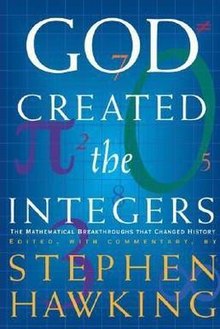 Cover of the first edition | |
| Author | Stephen Hawking |
|---|---|
| Language | English |
| Subject | Mathematics |
| Publisher | Running Press |
Publication date | 2005 (first edition) 2007 (second edition) |
| Media type | |
| Pages | 1176 |
| ISBN | 9780762419227 (first edition) 9780762430048 (second edition) |
| Preceded by | A Briefer History of Time |
| Followed by | The Grand Design |
God Created the Integers: The Mathematical Breakthroughs That Changed History is a 2005 anthology, edited by Stephen Hawking, of "excerpts from thirty-one of the most important works in the history of mathematics." [1]
Contents
Each chapter of the work focuses on a different mathematician and begins with a biographical overview. Within each chapter, Hawking examines the mathematician’s key discoveries, presents formal proofs of significant results, and explains their impact on the development of the mathematical field.
The title of the book is a reference to a quotation attributed to mathematician Leopold Kronecker, who once wrote that "God made the integers; all else is the work of man." [2]